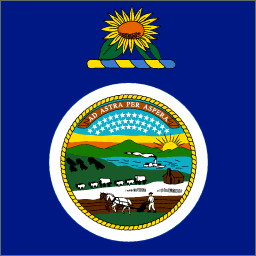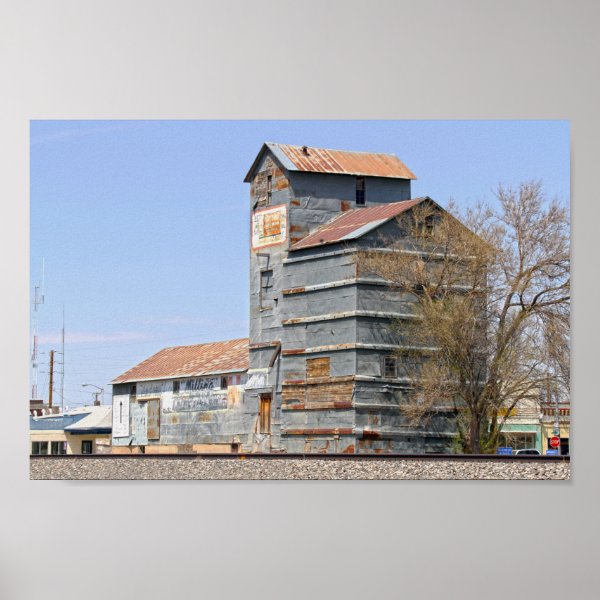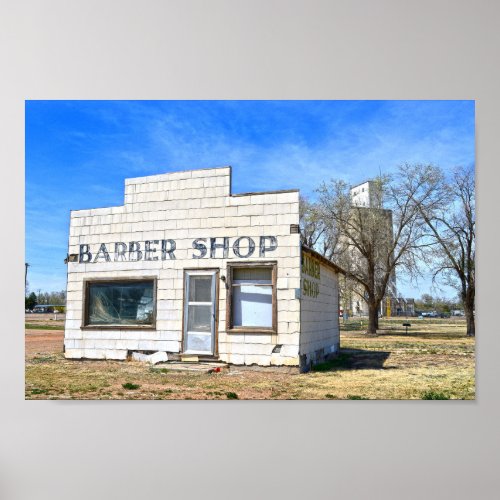
A bee loaded with bright yellow pollen works the huge head of a sunflower in a vast sunflower field near Quapaw, Oklahoma.
Kansas is the sunflower state, but we had to go to Oklahoma to find these vast sunflower crop fields (pictured above and at the bottom) near Quapaw in mid-September.

The sunflower crowns the seal on the Kansas state flag.
Heading south on Highway 69 in Kansas, we passed mile after mile of green soybean rows and the brown stalks of ready-to-harvest feed corn. Cattle and horse grazed in lush pastures. It was the kind of perfect late summer day you want to bottle so you can release it in January.
The small yellow heads of wild sunflowers cheered us along the roadside and in fields that had escaped mowing and grazing, but it wasn’t until we crossed into Oklahoma that we really saw SUNFLOWERS –brilliant yellow that stretched as far as I could see. Thankfully, I was wearing sunglasses, or I’d be blind today!

A Cloudless Sulphur butterfly nectars on a wild sunflower in a vacant lot.
The sunflower is the state flower of Kansas, so I’m sure it was the first flower I ever learned about. Helianthus annuus, the annual sunflower, comes in 60 species. Some species can grow as tall as fifteen feet. The flower heads can be small as buttons or be as large as dinner plates. I don’t think I’m biased, but the sunflower has got my vote as the most useful flower in the world. If you can think of a more useful one, let me know. (I’m making my case below.)
Native Americans discovered and domesticated the sunflower as early as 2,300 B.C. The earliest example of a fully domesticated sunflower was found in Tennessee. The Incas used the sunflower as an image of their sun god, and the sunflower is regarded as the floral emblem of Peru. Native Americans grew and used the sunflower for both food and oil. They made a yellow dye from the flower heads and fiber from the stalks.
The oil can be used for cooking, soap-making and even in the manufacture of paint. I’ve used oil paints with sunflower oil, rather than linseed, in art. Domesticated sunflowers are grown ornamentally and for crops — seeds, oil and high-protein cattle feed. You can eat the seeds or make butter out of them. The leaves can be used for cattle fodder. Sunflowers even produce latex. No part is wasted.
Many birds love sunflower seeds, and some crop varieties have been developed with drooping heads to make it more difficult for the birds to get at the seeds.

Sunflowers in a plot in Fenway Victory Gardens in Boston.
There are the weedy types that thrive along roadsides and in uncultivated areas that provide essential habitat for wildlife and insects. Sunflowers are also good nectar and pollen sources. Some wild types creep into crop fields, where they’re popular with bees and butterflies, but not farmers.
Many composite flowers — the actual flowers are crammed together in the head — are called sunflowers, including some perennial species. The petals — or rays — can be yellow, maroon, orange or even other colors.
The Spanish introduced the sunflower into Europe in 1510, and sunflowers are now grown throughout the world. Russia is the leading grower, followed by Argentina, the United States and Canada. During the 18th century in Europe, members of the Russian Orthodox Church helped to make sunflower oil popular because it was one of the few oils not prohibited during Lent. This could explain why Russia leads in its cultivation.
The seeds are used as chicken feed — and perhaps not coincidentally, two famous chicken restaurants in Pittsburg, Kansas, are not far from Quapaw– Chicken Annie’s and Chicken Mary’s.

Sunflowers grow in the demonstration garden at the National Agricultural Center and Hall of Fame in Bonner Springs, Kansas.
The tuberous roots of the Helianthus tuberosus, the Jerusalem artichoke, can be eaten. Now called a sunchoke, the old Jerusalem name of this perennial sunflower came from the Italian word for sunflower, girasole. I’ve never tried a sunchoke, but it sounds interesting, if not delicious.
To learn more about sunflowers, click here.

Endless fields of sunflowers near Quapaw, Oklahoma.


























































